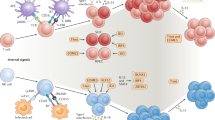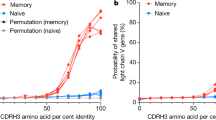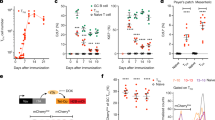Abstract
THERE is considerable evidence that antibody-forming cells arise by mitotic division after injection of antigen, and that they continue to divide and produce antibody while differentiating (refs. 1–3 and unpublished work of N. K. Jerne, A. Nordin, C. Henry, H. Funi and A. Koros). According to this view, the many antibody-forming cells present at the peak of an immune response are derived by extensive proliferation from a relatively small number of precursors. It has been suggested, however, that plaque-forming cells which release 19S haemolytic antibody may develop from precursors without division4–6. If this is true it follows that lymphoid tissue must contain a large number of cells capable of being directly “switched on” for synthesis of a specific antibody. Experiments designed to test this point are described here.
This is a preview of subscription content, access via your institution
Access options
Subscribe to this journal
Receive 51 print issues and online access
$199.00 per year
only $3.90 per issue
Buy this article
- Purchase on Springer Link
- Instant access to full article PDF
Prices may be subject to local taxes which are calculated during checkout
Similar content being viewed by others
References
Baney, R. N., Vazquez, J. J., and Dixon, F. J., Proc. Soc. Exp. Biol. and Med., 109, 1 (1962).
Nossal, G. J. V., and Mäkelä, O., J. Exp. Med., 115, 209 (1962).
Balfour, B. M., Cooper, E. H., and Alpen, E. L., Immunology, 8, 230 (1965).
Sterzl, J., Vesely, J., Jilek, M., and Mandel, L., in Molecular and Cellular Basis of Antibody Formation (edit. by Sterzl, J.), 463 (Academic Press, New York, 1965).
Tannenberg, W. J. K., Nature, 214, 293 (1967).
Eidinger, D., and Pross, H. F., J. Exp. Med., 126, 15 (1967).
Cunningham, A. J., Smith, J. B., and Mercer, E. H., J. Exp. Med., 124, 701 (1966).
Cunningham, A. J., Austral. J. Exp. Biol. Med. Sci. (in the press).
Kern, M., and Eisen, H. N., J. Exp. Med., 110, 207 (1959).
Ford, W. L., Gowans, J. L., and McCullagh, P. J., in The Thymus, Ciba Found. Symp. (edit. by Wolstenholme, G. E. W., and Porter, R.), 58 (J. and A. Churchill, Ltd., London, 1966).
Author information
Authors and Affiliations
Rights and permissions
About this article
Cite this article
SZENBERG, A., CUNNINGHAM, A. DNA Synthesis in the Development of Antibody-forming Cells during the Early Stages of the Immune Response. Nature 217, 747–748 (1968). https://doi.org/10.1038/217747a0
Received:
Issue Date:
DOI: https://doi.org/10.1038/217747a0
This article is cited by
-
Determination of S-period and cell cycle time of 19S hemolysin producing spleen cells of mice cultured in vitro
Zeitschrift f�r Zellforschung und Mikroskopische Anatomie (1972)
-
Evidence for RNA-DNA Complexes in Haemolytic Plaque-forming Cells containing Ribonuclease Resistant RNA
Nature New Biology (1971)
-
Effect of the immunosuppressive agent ovalicin on the kinetics of antibody formation
Agents and Actions (1970)
-
DNA Synthesis by Antibody-forming Cells during the Primary Immune Response
Nature (1969)
-
Colture in vitro di cellule spleniche di topo
Zeitschrift f�r Zellforschung und Mikroskopische Anatomie (1969)
Comments
By submitting a comment you agree to abide by our Terms and Community Guidelines. If you find something abusive or that does not comply with our terms or guidelines please flag it as inappropriate.



